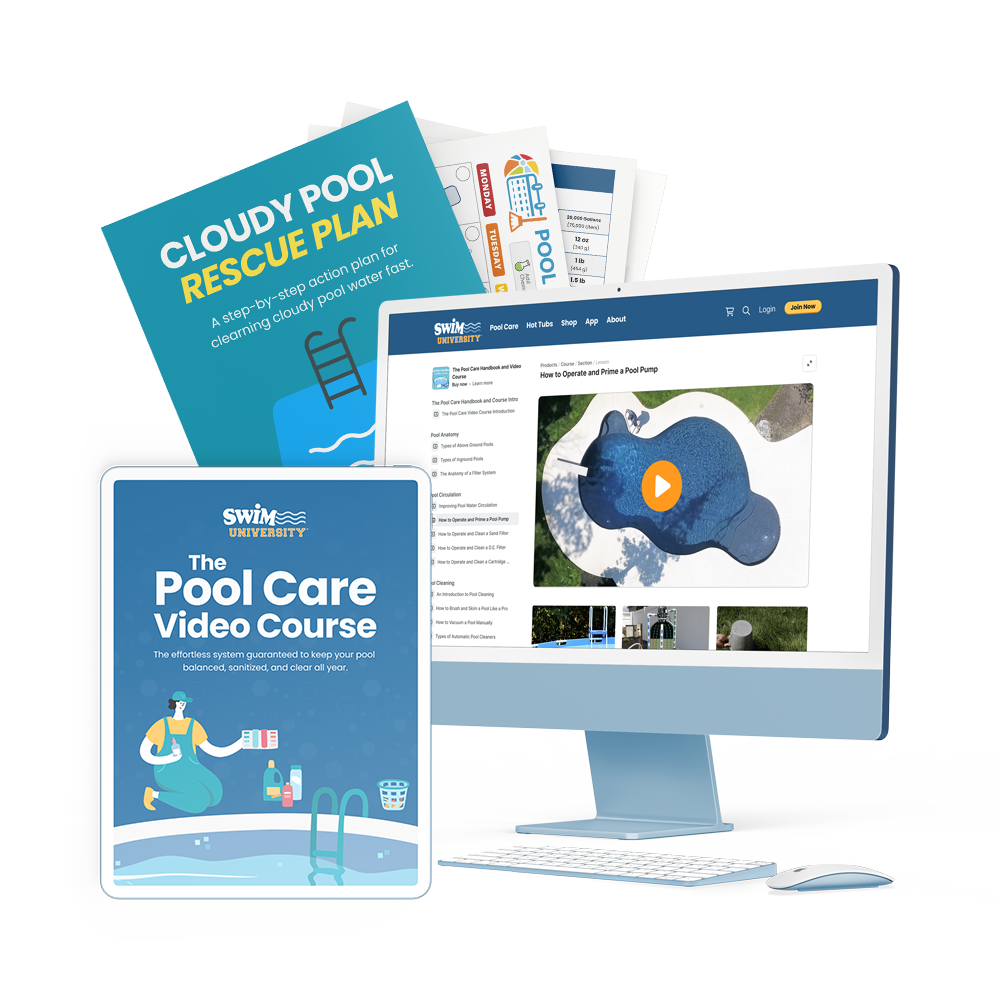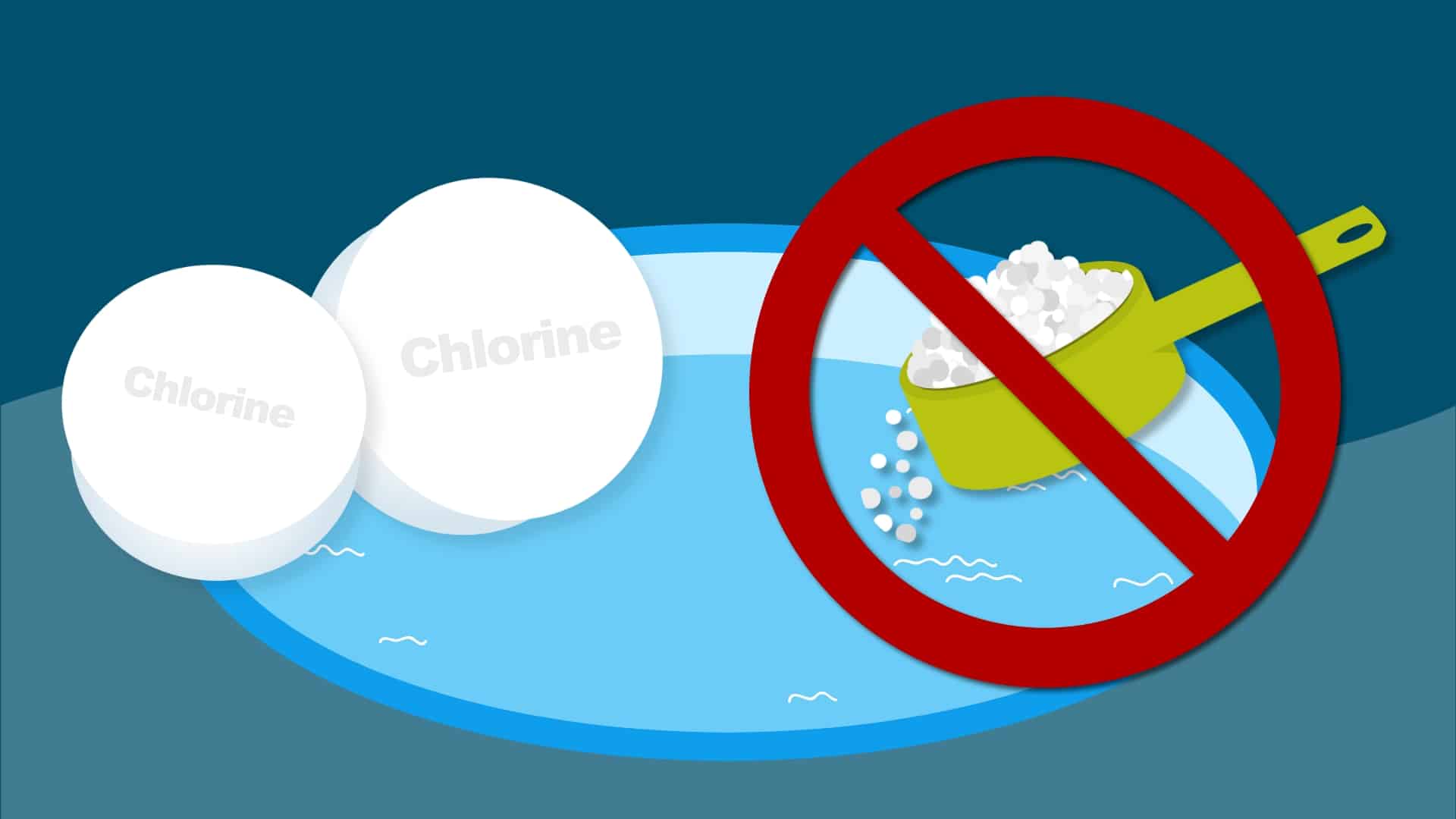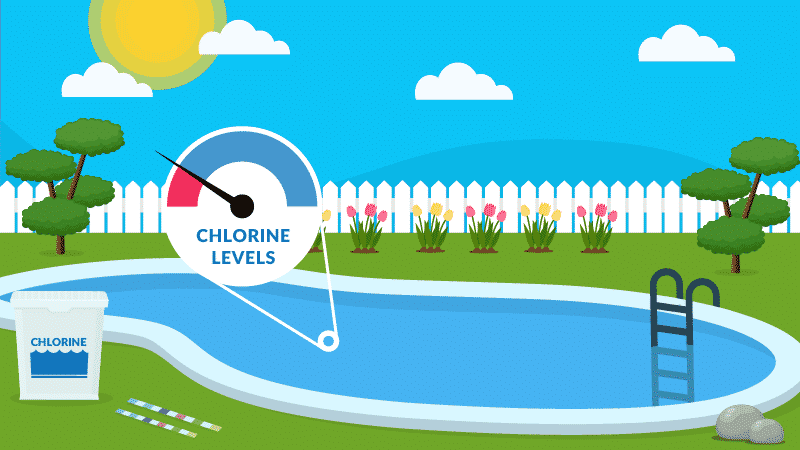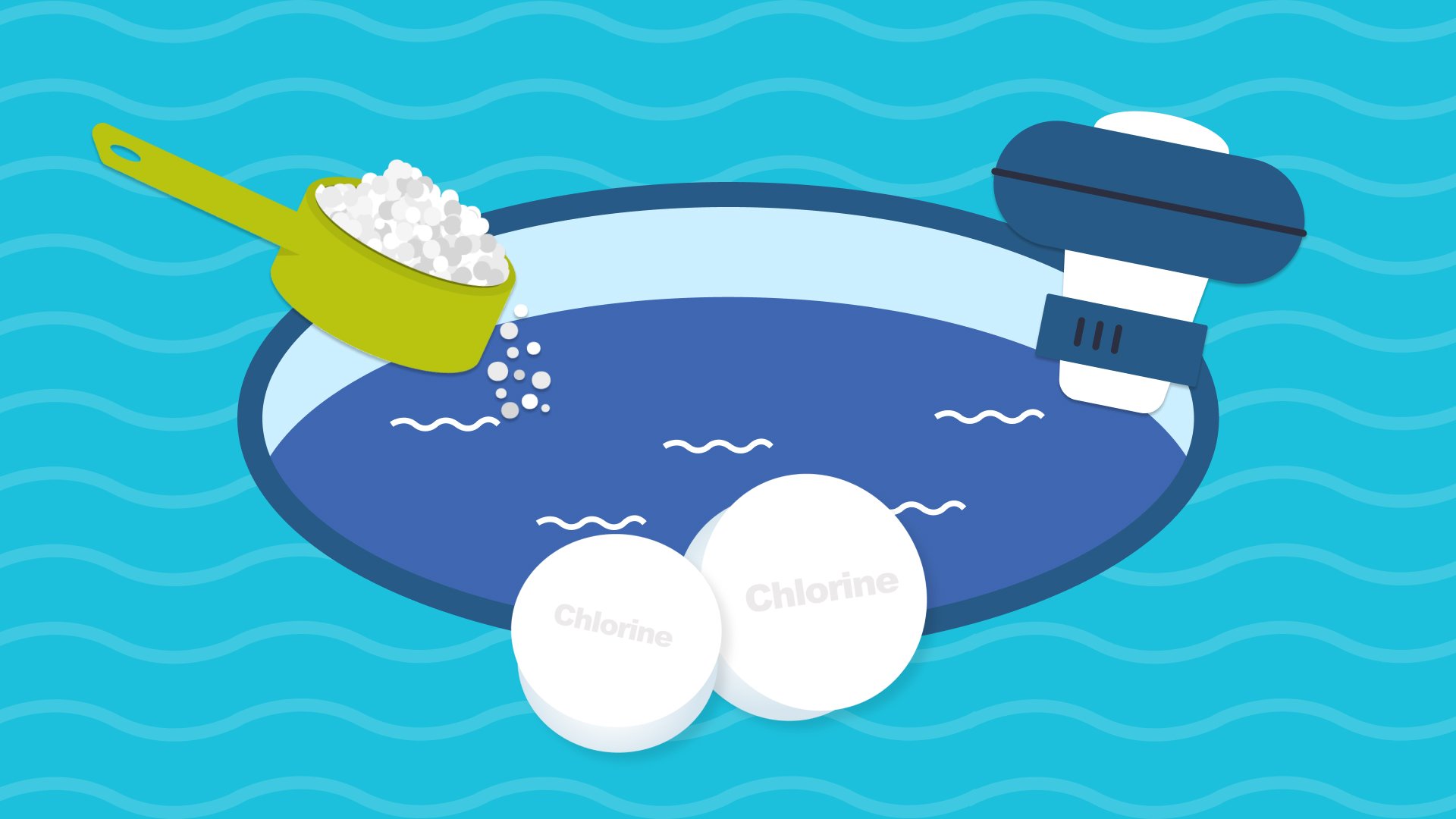Can You Put Bleach in a Pool to Keep It Clean?
Did you know you can replace most of your expensive pool chemicals with common household products? If you want to stop spending extra money on things like chlorine tablets or alkalinity increaser, here’s what to use instead:
- Bleach (like Clorox)
- Baking soda (like Arm & Hammer)
- Soda ash
- And Muriatic Acid
Knowing how to use each one could help you save hundreds on pool chemicals. So here’s a step-by-step guide on how to maintain your pool by using things you find at the grocery store or hardware store. Let’s dive in.
Stop wasting time and money with confusing water chemistry and maintenance. Our effortless system guarantees to keep your pool balanced, sanitized, and crystal clear all year. Works for all pools including saltwater.
The Most Important Chemicals For Your Pool
When it comes to your pool’s water chemistry, there are a few levels that matter the most for regular, weekly maintenance: Chlorine, pH, Alkalinity, and Cyanuric Acid.
The right chlorine levels keep your water sanitized and free from bacteria and algae. The proper pH keeps your water neutral, not too acidic or too basic.
Two other elements help maintain chlorine and pH: total alkalinity, which prevents pH from fluctuating wildly, and Cyanuric Acid, or CYA, which helps protect chlorine from breaking down in the sun.
To keep these levels in check, you’ll need to test your water at least once a week and add the right chemicals to rebalance your water chemistry. That usually means going to the pool store and buying chemicals like:
- Alkalinity increaser
- pH increaser
- pH decreaser
- Chlorine tablets or granules
- And Chlorine Stabilizer
Depending on the size of your pool, that list can cost you hundreds of dollars. The good news is most of these chemicals can actually be replaced with regular store-bought items. You can find their substitutes in the laundry aisle, the baking section, or at your local hardware store. Most of them have the SAME ACTIVE INGREDIENT as the pool chemical they replace.
How to Maintain Your Pool with Common Household Chemicals
A quick note before adding ANYTHING to your water:
- Test your levels so you know what needs adjusting.
- And always wear the right safety gear, like goggles and gloves, even when using household products.
- You’ll also want to add things slowly to your water with your pump and filter running.
- And retest your water chemistry in between dosing.
- Finally, make sure you adjust your water chemistry in the right order. For the best results, follow this sequence: balance alkalinity first, then pH, and finally chlorine. They each affect one another, so balancing them in the correct order will help.
1. Use Baking Soda to Raise your Alkalinity
Alkalinity Increaser sold at the pool store has just one active ingredient: sodium bicarbonate. Sodium bicarbonate is just baking soda. So, adding baking soda to your water will raise your alkalinity levels. It will also slightly raise your pH since alkalinity and pH work hand-in-hand, but you’ll notice a greater change in your alkalinity.
How much baking soda do you need? For every 10,000 gallons of water, you’ll need about 1.5 pounds of baking soda to raise your alkalinity by 10 PPM. After you raise your Alkalinity, your pH might naturally rise with it.
An affordable alternative to traditional chemicals, baking soda will naturally raise the alkalinity and pH in your water. It's also useful for cleaning tiles and surfaces.
2. Use Soda Ash to Raise your pH
Soda ash, a.k.a. Washing soda, has the same active ingredient as pH Increaser – and that’s sodium carbonate. Found in the laundry aisle, soda ash can be used to raise your pH. Just make sure your soda ash is 100% sodium carbonate without any additives. You might also see tubs of soda ash in the pool store. But you can usually find it cheaper elsewhere.
How much soda ash do you need? For every 10,000 gallons of water, it takes about half a pound of soda ash to raise your pH by 0.2. If your pH is lower than 7, start by adding 1 pound of soda ash at a time for every 10,000 gallons of water. Keep in mind that your total alkalinity will go up slightly too. But you’ll notice a greater change in pH.
This is the main chemical used to increase your pool's pH. So instead of using a branded version of pH Increaser, you can just use soda ash.
But here’s an even better secret: you can bring up your pH levels without any chemicals at all. Aerating your water with a water fountain or water feature will naturally raise your pH levels without affecting your alkalinity and without having to add anything to your water. Be sure to check out our other video about raising pH for more help.
3. Use Muriatic Acid to Lower your pH and Alkalinity
Muriatic acid can replace
How much muriatic acid do you need? If your pH is between 7.8 and 8.0, you’ll need about a pint (or 2 cups) of muriatic acid for every 10,000 gallons of water. This will bring your pH back down into the proper range between 7.4 and 7.6. If you have a smaller pool, start extra slowly and add one cup or less of muriatic acid at a time.
Used for lowering alkalinity and pH in your pool water. It's also used for cleaning pool filter grids, filter cartridges, and concrete pool surfaces.
4. Use Bleach or Liquid Chlorine to Sanitize Your Water
You need chlorine to keep your water sanitized. But it doesn’t have to be chlorine tablets or granules. You can use liquid bleach or liquid chlorine instead.
Household bleach and liquid chlorine both contain the same active ingredient: sodium hypochlorite. Liquid chlorine contains around 10 to 12 percent chlorine by volume. Bleach from the grocery store is less concentrated, with around 7 to 8 percent.
If you’re buying bleach, make sure it’s 100% sodium hypochlorite and there’s no added scents or ingredients. Better yet, look for labels at the store that say “chlorinating liquid.” This usually has a higher concentration of chlorine.
For a maintenance dose of liquid chlorine, you’ll need about 1 gallon for every 10,000 gallons of water. This should bring your chlorine into range if it’s on the low-ish side (around 1 PPM). If you’re using bleach, you’ll need about double the dose since it’s less concentrated.
Bleach with 7.5% sodium hypochlorite offers powerful sanitizing capabilities.
When adding it to your pool, just be sure to pour it around the perimeter of your pool with the jets running so it doesn’t settle on any surfaces and bleach your liner. Check out our other video for more help on how to add chlorine the right way.
The downside to bleach or liquid chlorine is how much you’ll need to have on hand to keep your water sanitized. It’s definitely heavier and takes up more space than chlorine granules or tablets. And if you need to shock your pool, say to get rid of algae, you’ll need to add twice or triple the amount to your water. But this type of chlorine can be a good option for smaller pools that are 10,000 gallons or less.
What About Salt Water Pools?
Bleach or liquid chlorine can be a great option for shocking your pool if you have algae or cloudy water. But you shouldn’t need to worry about adding any extra chlorine as long as your salt water generator is running properly.
There are two other pool chemicals you still might need to buy: chlorine stabilizer and calcium hardness increaser.
5. Chlorine Stabilizer (a.k.a. Cyanuric Acid or CYA)
CYA helps protect your chlorine from breaking down under the sun’s UV rays. Chlorine tablets and granules are types of stabilized chlorine, meaning they already contain CYA. Bleach or liquid chlorine does not, which makes it unstabilized. That means it’ll break down quickly in direct sunlight. Salt water pools also need stabilizer to help protect the chlorine it produces.
If you’re using bleach or liquid chlorine to sanitize your pool, you have two choices: you can either add chlorine almost every day to your water after it breaks down in the sun. Or you can add a chlorine stabilizer, a.k.a. Cyanuric acid, to your water to keep your chlorine protected. Your CYA levels should be between 30 and 50 PPM.
6. Calcium Hardness Increaser
Low calcium hardness levels in your water can corrode your pool surfaces and equipment. And high calcium hardness can cause scaling and buildup. If it’s too low, you’ll need to add calcium hardness increaser. But if you take down your pool every year, you don’t need to worry about the hardness in your water. That’s because the erosion from low calcium hardness levels happens over a longer period of time.
Finally, no matter what products you add to your water, they won’t work if you don’t keep your filter and your pool’s surfaces clean. So make sure you’re cleaning or backwashing your filter, skimming your surfaces, and brushing and vacuuming your pool.
4 Ways We Can Help With Your Pool
- Pool Care Cheat Sheets (Free): Easy-to-use downloadable guides to help you keep track of taking care of your pool this year.
- The Pool Care Handbook: An illustrated guide to DIY pool care, including water chemistry, maintenance, troubleshooting, and more.
- The Pool Care Video Course: You’ll get 30+ step-by-step videos and a downloadable guide with everything you need to know about pool maintenance.
- The Pool Care App: Enter your water test results. Get a custom treatment plan. Know exactly what chemicals to add to keep your pool clear.













